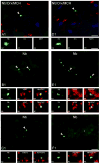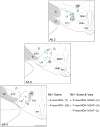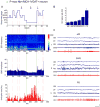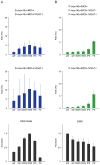GABAergic neurons intermingled with orexin and MCH neurons in the lateral hypothalamus discharge maximally during sleep
- PMID: 20597977
- PMCID: PMC2921479
- DOI: 10.1111/j.1460-9568.2010.07295.x
GABAergic neurons intermingled with orexin and MCH neurons in the lateral hypothalamus discharge maximally during sleep
Abstract
The lateral hypothalamus (LH), where wake-active orexin (Orx)-containing neurons are located, has been considered a waking center. Yet, melanin-concentrating hormone (MCH)-containing neurons are codistributed therein with Orx neurons and, in contrast to them, are active during sleep, not waking. In the present study employing juxtacellular recording and labeling of neurons with Neurobiotin (Nb) in naturally sleeping-waking head-fixed rats, we identified another population of intermingled sleep-active cells, which do not contain MCH (or Orx), but utilize gamma-aminobutyric acid (GABA) as a neurotransmitter. The 'sleep-max' active neurons represented 53% of Nb-labeled MCH-(and Orx) immunonegative (-) cells recorded in the LH. For identification of their neurotransmitter, Nb-labeled varicosities of the Nb-labeled/MCH- neurons were sought within sections adjacent to the Nb-labeled soma and immunostained for the vesicular transporter for GABA (VGAT) or for glutamate. A small proportion of sleep-max Nb+/MCH- neurons (19%) discharged maximally during slow-wave sleep (called 'S-max') in positive correlation with delta electroencephalogram activity, and from VGAT staining of Nb-labeled varicosities appeared to be GABAergic. The vast proportion of sleep-max Nb+/MCH- neurons (81%) discharged maximally during paradoxical sleep (PS, called 'P-max') in negative correlation with electromyogram amplitude, and from Nb-labeled varicosities also appeared to be predominantly GABAergic. Given their discharge profiles across the sleep-wake cycle, P-max together with S-max GABAergic neurons could thus serve to inhibit other neurons of the arousal systems, including local Orx neurons in the LH. They could accordingly dampen arousal with muscle tone and promote sleep, including PS with muscle atonia.
Figures





Similar articles
-
Melanin-concentrating hormone neurons discharge in a reciprocal manner to orexin neurons across the sleep-wake cycle.Proc Natl Acad Sci U S A. 2009 Feb 17;106(7):2418-22. doi: 10.1073/pnas.0811400106. Epub 2009 Feb 2. Proc Natl Acad Sci U S A. 2009. PMID: 19188611 Free PMC article.
-
Opposite effects of noradrenaline and acetylcholine upon hypocretin/orexin versus melanin concentrating hormone neurons in rat hypothalamic slices.Neuroscience. 2005;130(4):807-11. doi: 10.1016/j.neuroscience.2004.10.032. Neuroscience. 2005. PMID: 15652980
-
Immunohistochemical evidence for synaptic release of GABA from melanin-concentrating hormone containing varicosities in the locus coeruleus.Neuroscience. 2012 Oct 25;223:269-76. doi: 10.1016/j.neuroscience.2012.07.072. Epub 2012 Aug 10. Neuroscience. 2012. PMID: 22890079
-
Lateral hypothalamus as a sensor-regulator in respiratory and metabolic control.Physiol Behav. 2013 Sep 10;121:117-24. doi: 10.1016/j.physbeh.2013.03.023. Epub 2013 Apr 3. Physiol Behav. 2013. PMID: 23562864 Free PMC article. Review.
-
Activation of the basal forebrain by the orexin/hypocretin neurones.Acta Physiol (Oxf). 2010 Mar;198(3):223-35. doi: 10.1111/j.1748-1716.2009.02036.x. Epub 2009 Sep 1. Acta Physiol (Oxf). 2010. PMID: 19723027 Free PMC article. Review.
Cited by
-
Distinct Types of Feeding Related Neurons in Mouse Hypothalamus.Front Behav Neurosci. 2016 May 18;10:91. doi: 10.3389/fnbeh.2016.00091. eCollection 2016. Front Behav Neurosci. 2016. PMID: 27242460 Free PMC article.
-
Lack of hypocretin attenuates behavioral changes produced by glutamatergic activation of the perifornical-lateral hypothalamic area.Sleep. 2014 May 1;37(5):1011-20. doi: 10.5665/sleep.3680. Sleep. 2014. PMID: 24790280 Free PMC article.
-
Intrinsic voltage dynamics govern the diversity of spontaneous firing profiles in basal forebrain noncholinergic neurons.J Neurophysiol. 2012 Jul;108(2):406-18. doi: 10.1152/jn.00642.2011. Epub 2012 Apr 11. J Neurophysiol. 2012. PMID: 22496531 Free PMC article.
-
Antagonistic interplay between hypocretin and leptin in the lateral hypothalamus regulates stress responses.Nat Commun. 2015 Feb 19;6:6266. doi: 10.1038/ncomms7266. Nat Commun. 2015. PMID: 25695914 Free PMC article.
-
Hubs and spokes of the lateral hypothalamus: cell types, circuits and behaviour.J Physiol. 2016 Nov 15;594(22):6443-6462. doi: 10.1113/JP271946. Epub 2016 Jul 19. J Physiol. 2016. PMID: 27302606 Free PMC article. Review.
References
-
- Boissard R, Fort P, Gervasoni D, Barbagli B, Luppi PH. Localization of the GABAergic and non-GABAergic neurons projecting to the sublaterodorsal nucleus and potentially gating paradoxical sleep onset. Eur J Neurosci. 2003;18:1627–1639. - PubMed
-
- Broberger C, De Lecea L, Sutcliffe JG, Hokfelt T. Hypocretin/orexin- and melanin-concentrating hormone-expressing cells form distinct populations in the rodent lateral hypothalamus: relationship to the neuropeptide Y and agouti gene-related protein systems. J Comp Neurol. 1998;402:460–474. - PubMed
Publication types
MeSH terms
Substances
Grants and funding
LinkOut - more resources
Full Text Sources
Molecular Biology Databases

